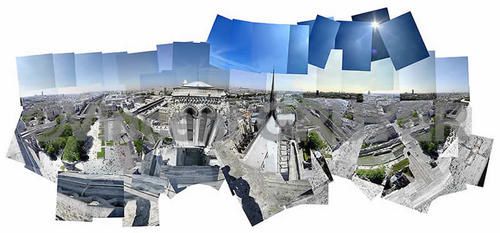Panorama South Tower West FacadeNotre Dame Archbishop of ParisFrance

Panorama: The South Tower in the West Facade, Notre Dame in Paris, Archbishop of Paris, France
33 / 48°51'.11. N 2°20’56. E /16.05.2004 / 13h10-13h30 T.U.
The South Tower in the West Facade, Notre Dame - 6 place du Parvis de Notre Dame - Archbishop of Paris -75004 Paris - Department of Paris - Ile-de-France (region) - France - Europe - Northern Hemisphere - Earth - Solar system - Milky Way
Limited edition, number 1 to 6, dimension 120 x 240 cm, Prix : 1500 euros without framed
Limited edition, number 7 to 13, dimension 60 x 90 cm, Prix : 400 euros without framed
Limited edition, number 14 to 21, dimension 30 x 40 cm, Prix : 100 euros without framed
Limited edition, number 22 to 30, dimension 21 x 29,7 cm, Prix : 50 euros without framed
Limited edition, number 7 to 13, dimension 60 x 90 cm, Prix : 400 euros without framed
Limited edition, number 14 to 21, dimension 30 x 40 cm, Prix : 100 euros without framed
Limited edition, number 22 to 30, dimension 21 x 29,7 cm, Prix : 50 euros without framed
Notre Dame de Paris, known simply as Notre Dame in English, is a Gothic cathedral on the eastern half of the Île de la Cité in Paris, France, with its main entrance to the west. It is still used as a Roman Catholic cathedral and is the seat of the Archbishop of Paris. Notre Dame de Paris is widely considered one of the finest examples of French Gothic architecture. It was restored and saved from destruction by Viollet-le-Duc, one of France's most famous architects. Notre Dame translates as "Our Lady" from French.
Notre Dame de Paris was one of the first Gothic cathedrals, and its construction spanned the Gothic period. Its sculptures and stained glass show the heavy influence of naturalism, giving them a more secular look that was lacking from earlier Romanesque architecture.
Notre Dame de Paris was among the first buildings in the world to use the flying buttress. The building was not originally designed to include the flying buttresses around the choir and nave. After the construction began and the thinner walls (popularized in the Gothic style) grew ever higher, stress fractures began to occur as the walls pushed outward. So, naturally, the cathedral's architects built supports around the outside walls and later additions continued as such.
At the end of the 18th century, during the French Revolution, many of the treasures of the cathedral were either destroyed or plundered. The statues of biblical kings of Judea (erroneously thought to be kings of France) were beheaded. Many of the heads were found during a 1977 excavation nearby and are on display at the Musée de Cluny. Only the great bells avoided being melted down, and the cathedral was dedicated first to the Cult of Reason, and to the Cult of the Supreme Being. The church interior was used as a warehouse for the storage of forage and food.
During the Paris Commune in 1871, the cathedral was nearly burned by the Communards — some accounts suggest that indeed a huge mound of chairs was set on fire in its interior. Whatever happened, Notre Dame survived the Commune essentially unscathed.
From Wikipedia
